German Renaissance
| Renaissance |
|---|
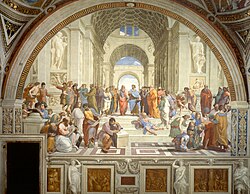 |
| Aspects |
| Regions |
| History and study |
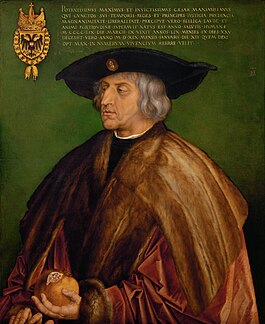
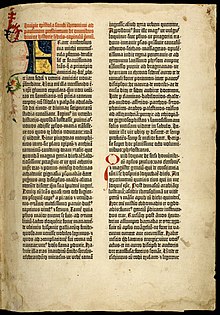
TheGerman Renaissance,part of theNorthern Renaissance,was a cultural and artistic movement that spread amongGermanthinkers in the 15th and 16th centuries, which developed from theItalian Renaissance.Many areas of the arts and sciences were influenced, notably by thespread of Renaissance humanism to the various German states and principalities.There were many advances made in the fields of architecture, the arts, and the sciences. Germany produced two developments that were to dominate the 16th century all over Europe:printingand theProtestant Reformation.
One of the most important German humanists wasKonrad Celtis(1459–1508). Celtis studied atCologneandHeidelberg,and later travelled throughout Italy collecting Latin and Greek manuscripts. Heavily influenced byTacitus,he used theGermaniato introduceGerman historyand geography. Eventually he devoted his time to poetry, in which he praised Germany in Latin. Another important figure wasJohann Reuchlin(1455–1522) who studied in various places in Italy and later taught Greek. He studied theHebrew language,aiming to purify Christianity, but encountered resistance from the church.
The most significant German Renaissance artist isAlbrecht Dürerespecially known for hisprintmakinginwoodcutandengraving,which spread all over Europe, drawings, and painted portraits. Important architecture of this period includes theLandshut Residence,Heidelberg Castle,theAugsburg Town Hallas well as theAntiquariumof theMunich Residenzin Munich, the largest Renaissance hall north of the Alps.[1][circular reference]
Background
[edit]TheRenaissancewas largely driven by the renewed interest in classical learning, and was also the result of rapid economic development. At the beginning of the 16th century, Germany (referring to the lands contained within the Holy Roman Empire) was one of the most prosperous areas in Europe despite a relatively low level of urbanization compared to Italy or the Netherlands.[2][full citation needed]It benefited from the wealth of certain sectors such as metallurgy, mining, banking and textiles. More importantly, book-printing developed in Germany, andGerman printers dominatedthe new book-trade in most other countries until well into the 16th century.
Art
[edit]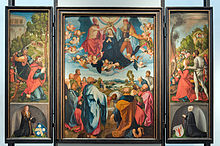
The concept of the Northern Renaissance or German Renaissance is somewhat confused by the continuation of the use of elaborate Gothic ornament until well into the 16th century, even in works that are undoubtedly Renaissance in their treatment of the human figure and other respects. Classical ornament had little historical resonance in much of Germany, but in other respects Germany was very quick to follow developments, especially in adoptingprintingwithmovable type,a German invention that remained almost a German monopoly for some decades, and wasfirst brought to most of Europe,including France and Italy, by Germans.[citation needed]

Printmakingbywoodcutandengravingwas already more developed in Germany and theLow Countriesthan elsewhere in Europe, and the Germans took the lead in developing book illustrations, typically of a relatively low artistic standard, but seen all over Europe, with the woodblocks often being lent to printers of editions in other cities or languages. The greatest artist of the German Renaissance,Albrecht Dürer,began his career as an apprentice to a leading workshop in Nuremberg, that ofMichael Wolgemut,who had largely abandoned his painting to exploit the new medium. Dürer worked on the most extravagantly illustrated book of the period, theNuremberg Chronicle,published by his godfatherAnton Koberger,Europe's largest printer-publisher at the time.[3]
After completing his apprenticeship in 1490, Dürer travelled in Germany for four years, and Italy for a few months, before establishing his own workshop in Nuremberg. He rapidly became famous all over Europe for his energetic and balanced woodcuts and engravings, while also painting. Though retaining a distinctively German style, his work shows strong Italian influence, and is often taken to represent the start of the German Renaissance in visual art, which for the next forty years replaced the Netherlands and France as the area producing the greatest innovation in Northern European art. Dürer supportedMartin Lutherbut continued to createMadonnasand other Catholic imagery, and paint portraits of leaders on both sides of the emerging split of theProtestant Reformation.[3]
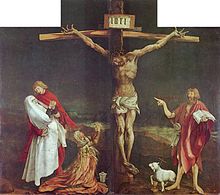
Dürer died in 1528, before it was clear that the split of the Reformation had become permanent, but his pupils of the following generation were unable to avoid taking sides. Most leading German artists became Protestants, but this deprived them of painting most religious works, previously the mainstay of artists' revenue.Martin Lutherhad objected to much Catholic imagery, but not to imagery itself, andLucas Cranach the Elder,a close friend of Luther, had painted a number of "Lutheran altarpieces", mostly showing theLast Supper,some with portraits of the leading Protestant divines as theTwelve Apostles.This phase of Lutheran art was over before 1550, probably under the more fiercelyaniconicinfluence ofCalvinism,and religious works for public display virtually ceased to be produced in Protestant areas. Presumably largely because of this, the development of German art had virtually ceased by about 1550, but in the preceding decades German artists had been very fertile in developing alternative subjects to replace the gap in their order books. Cranach, apart from portraits, developed a format of thin vertical portraits of provocative nudes, given classical or Biblical titles.[4]
Lying somewhat outside these developments isMatthias Grünewald,who left very few works, but whose masterpiece, hisIsenheim Altarpiece(completed 1515), has been widely regarded as the greatest German Renaissance painting since it was restored to critical attention in the 19th century. It is an intensely emotional work that continues the German Gothic tradition of unrestrained gesture and expression, using Renaissance compositional principles, but all in that most Gothic of forms, the multi-wingedtriptych.[5]
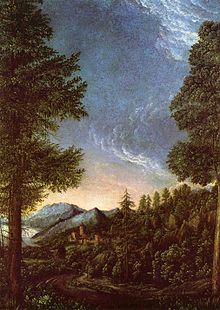
TheDanube Schoolis the name of a circle of artists of the first third of the 16th century inBavariaand Austria, includingAlbrecht Altdorfer,Wolf HuberandAugustin Hirschvogel.With Altdorfer in the lead, the school produced the first examples of independentlandscape artin the West (nearly 1,000 years after China), in both paintings and prints.[6]Their religious paintings had anexpressioniststyle somewhat similar to Grünewald's. Dürer's pupilsHans BurgkmairandHans Baldung Grienworked largely in prints, with Baldung developing the topical subject matter ofwitchesin a number of Enigma tic prints.[7]
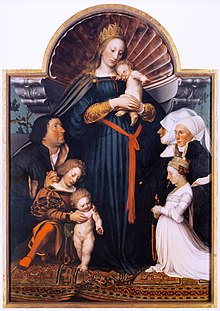
Hans Holbein the Elderand his brother Sigismund Holbein painted religious works in the late Gothic style. Hans the Elder was a pioneer and leader in the transformation of German art from the Gothic to the Renaissance style. His son,Hans Holbein the Youngerwas an important painter of portraits and a few religious works, working mainly in England and Switzerland. Holbein's well known series of small woodcuts on theDance of Deathrelate to the works of theLittle Masters,a group of printmakers who specialized in very small and highly detailed engravings for bourgeois collectors, including many erotic subjects.[9]
The outstanding achievements of the first half of the 16th century were followed by several decades with a remarkable absence of noteworthy German art, other than accomplished portraits that never rival the achievement of Holbein or Dürer. The next significant German artists worked in the rather artificial style ofNorthern Mannerism,which they had to learn in Italy or Flanders.Hans von Aachenand the NetherlandishBartholomeus Sprangerwere the leading painters at the Imperial courts inViennaand Prague, and the productive NetherlandishSadeler familyof engravers spread out across Germany, among other counties.[10]
In Catholic parts of South Germany the Gothic tradition of wood carving continued to flourish until the end of the 18th century, adapting to changes in style through the centuries.Veit Stoss(d. 1533),Tilman Riemenschneider(d.1531) andPeter Vischer the Elder(d. 1529) were Dürer's contemporaries, and their long careers covered the transition between the Gothic and Renaissance periods, although their ornament often remained Gothic even after their compositions began to reflect Renaissance principles.[11]
Architecture
[edit]Renaissance architecturein Germany was inspired first by German philosophers and artists such asAlbrecht DürerandJohannes Reuchlinwho visited Italy. Important early examples of this period are especially theLandshut Residence,theCastleinHeidelberg,Johannisburg PalaceinAschaffenburg,Schloss Weilburg,theCity HallandFugger HousesinAugsburgandSt. MichaelinMunich,the largest Renaissance church north of the Alps.
A particular form of Renaissance architecture in Germany is theWeser Renaissance,with prominent examples such as theCity HallofBremenand theJuleuminHelmstedt.
In July 1567 the city council ofCologneapproved a design in the Renaissance style by Wilhelm Vernukken for a two storied loggia forCologne City Hall.St MichaelinMunichis the largest Renaissance church north of the Alps. It was built byDuke William VofBavariabetween 1583 and 1597 as a spiritual center for theCounter Reformationand was inspired by the Church ofil Gesùin Rome. The architect is unknown. Many examples ofBrick Renaissancebuildings can be found inHanseaticold towns, such asStralsund,Wismar,Lübeck,Lüneburg,FriedrichstadtandStade.Notable German Renaissance architects includeFriedrich Sustris,Benedikt Rejt,Abraham van den Blocke,Elias HollandHans Krumpper.
Gallery
[edit]Influential people
[edit]Johannes Gutenberg (c. 1398–1468)
[edit]Born Johannes Gensfleisch zur Laden,[12]Johannes Gutenbergis widely considered the most influential person within the German Renaissance. As a free thinker, humanist, and inventor, Gutenberg also grew up within the Renaissance, but influenced it greatly as well. His best-known invention is theprinting pressin 1440. Gutenberg's press allowed the humanists, reformists, and others to circulate their ideas. He is also known as the creator of theGutenberg Bible,a crucial work that marked the start of theGutenberg Revolutionand the age of the printed book in theWestern world.
Johann Reuchlin (1455–1522)
[edit]Johann Reuchlinwas the most important aspect of world culture teaching within Germany at this time. He was a scholar of both Greek and Hebrew. Graduating, then going on to teach at Basel, he was considered extremely intelligent. Yet after leaving Basel, he had to start copying manuscripts and apprenticing within areas of law. However, he is most known for his work within Hebrew studies. Unlike some other "thinkers" of this time, Reuchlin submerged himself into this, even creating a guide to preaching within the Hebrew faith. The book, titledDe Arte Predicandi(1503), is possibly one of his best-known works from this period.
Albrecht Dürer (1471–1528)
[edit]Albrecht Dürerwas at the time, and remains, the most famous artist of the German Renaissance. He was famous across Europe, and greatly admired in Italy, where his work was mainly known through hisprints.He successfully integrated an elaborate Northern style with Renaissance harmony and monumentality. Among his best known works areMelencolia I,theFour Horsemenfrom hiswoodcutApocalypseseries, andKnight, Death, and the Devil.Other significant artists wereLucas Cranach the Elder,theDanube Schooland theLittle Masters.
Martin Luther (1483–1546)
[edit]Martin Luther[13]was a ProtestantReformerwho criticized church practices such as selling indulgences, against which he published in hisNinety-Five Thesesof 1517. Luther also translated theBibleinto German, making the Christian scriptures more accessible to the general population and inspiring the standardization of the German language.
Paracelsus (1493-1541)
Paracelsuswas an important philosopher, physician, chemist, alchemist, theologian and scientist of theGerman Renaissance.His works were accepted worldwide and paved the way for Modern Science, especially chemistry and medicine.
See also
[edit]References
[edit]- ^Munich Residenz
- ^German economic growth, 1500–1850,Ulrich Pfister
- ^abBartrum (2002)
- ^Snyder, Part III, Ch. XIX on Cranach, Luther etc.
- ^Snyder, Ch. XVII
- ^Wood, 9 – this is the main subject of the whole book
- ^Snyder, Ch. XVII, Bartrum, 1995
- ^"BBC - Dark arts: Holbein and the court of Henry VIII".BBC.Retrieved2021-12-30.
- ^Snyder, Ch. XX on the Holbeins, Bartrum (1995), 221–237 on Holbein's prints, 99–129 on the Little Masters
- ^Trevor-Roper, Levey
- ^Snyder, 298–311
- ^Johann Gutenbergat theNew Catholic Encyclopedia
- ^Plass, Ewald M. (1959). "Monasticism".What Luther Says: An Anthology.Vol. 2. St. Louis: Concordia Publishing House. p. 964.
Sources
[edit]- Bartrum, Giulia(1995);German Renaissance Prints, 1490–1550;British Museum Press, 1995,ISBN0-7141-2604-7
- Bartrum, Giulia (2002),Albrecht Dürer and his legacy: the graphic work of a Renaissance artist,British Museum Press, 2002,ISBN978-0-7141-2633-3
- Michael Levey,Painting at Court,Weidenfeld & Nicolson, London, 1971
- Snyder, James;Northern Renaissance Art,1985, Harry N. Abrams,ISBN0-13-623596-4
- Trevor-Roper, Hugh;Princes and Artists, Patronage and Ideology at Four Habsburg Courts 1517–1633,Thames & Hudson, London, 1976,ISBN0-500-23232-6
- Wood, Christopher S.,Albrecht Altdorfer and the Origins of Landscape,1993, Reaktion Books, London,ISBN0-948462-46-9
Further reading
[edit]- O'Neill, John P., ed. (1987).The Renaissance in the North.New York: The Metropolitan Museum of Art.ISBN0-87099-434-4.OCLC893699130.










